Stakeholder Relationship Management: Influence on Management Decision Making
VerifiedAdded on 2023/06/04
|10
|1695
|454
AI Summary
This presentation discusses the importance of effective stakeholder relationship management in determining the success or failure of an organization. It covers the steps for stakeholder management, effects of stakeholder management, and examples of good and poor stakeholder management. The presentation also highlights the influence of stakeholders on management decision making.
Contribute Materials
Your contribution can guide someone’s learning journey. Share your
documents today.
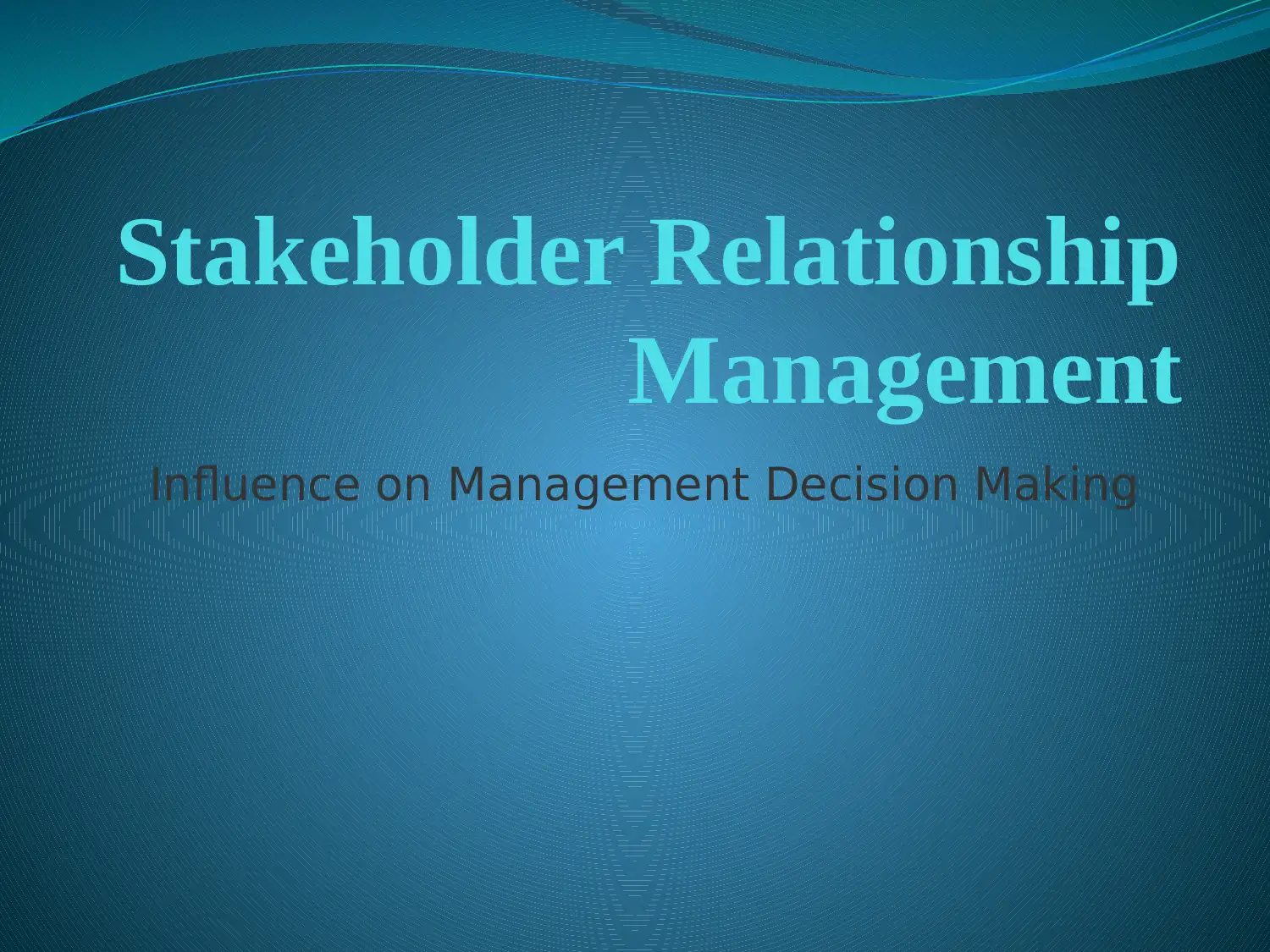
Stakeholder Relationship
Management
Influence on Management Decision Making
Management
Influence on Management Decision Making
Secure Best Marks with AI Grader
Need help grading? Try our AI Grader for instant feedback on your assignments.
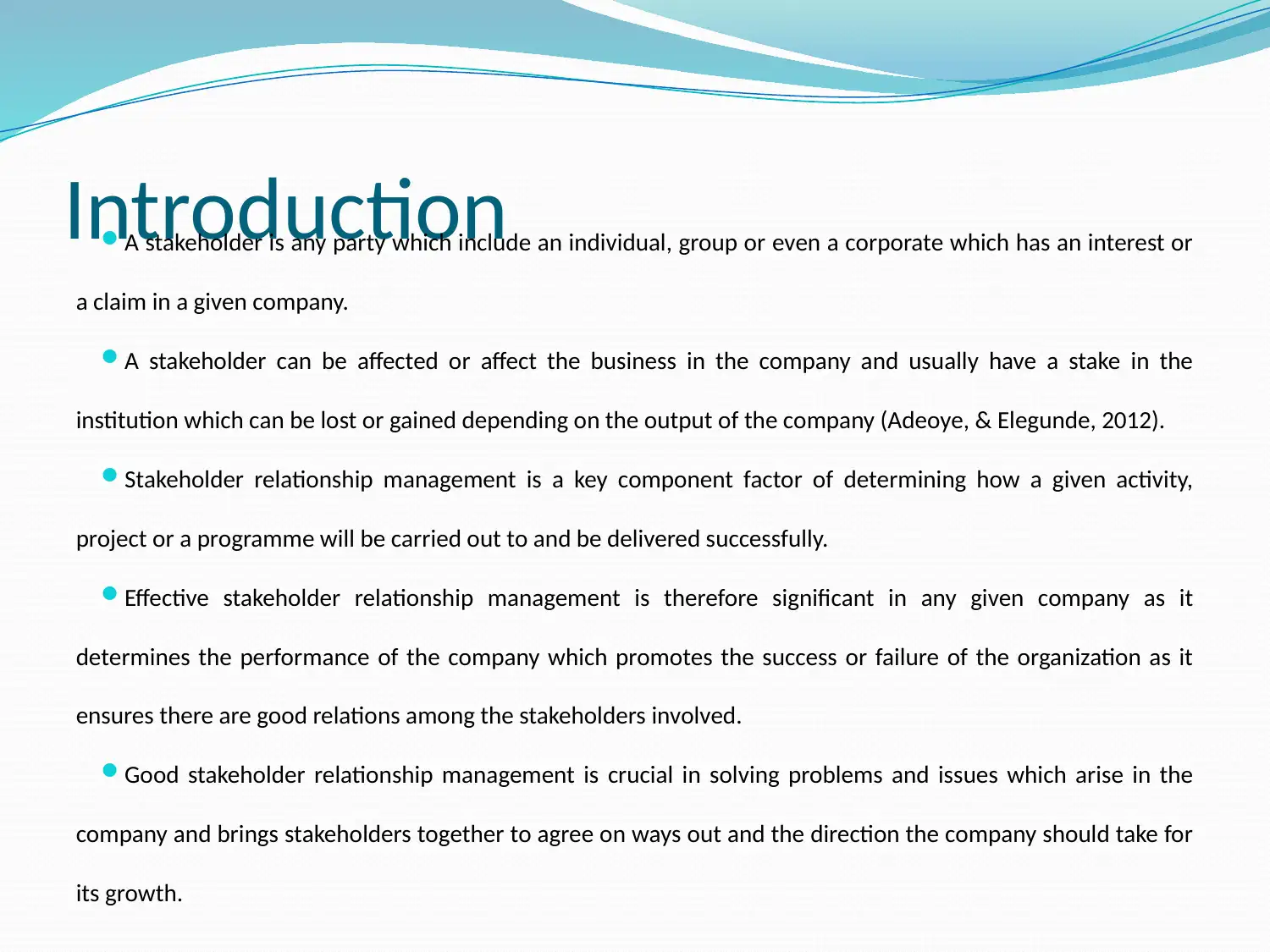
IntroductionA stakeholder is any party which include an individual, group or even a corporate which has an interest or
a claim in a given company.
A stakeholder can be affected or affect the business in the company and usually have a stake in the
institution which can be lost or gained depending on the output of the company (Adeoye, & Elegunde, 2012).
Stakeholder relationship management is a key component factor of determining how a given activity,
project or a programme will be carried out to and be delivered successfully.
Effective stakeholder relationship management is therefore significant in any given company as it
determines the performance of the company which promotes the success or failure of the organization as it
ensures there are good relations among the stakeholders involved.
Good stakeholder relationship management is crucial in solving problems and issues which arise in the
company and brings stakeholders together to agree on ways out and the direction the company should take for
its growth.
a claim in a given company.
A stakeholder can be affected or affect the business in the company and usually have a stake in the
institution which can be lost or gained depending on the output of the company (Adeoye, & Elegunde, 2012).
Stakeholder relationship management is a key component factor of determining how a given activity,
project or a programme will be carried out to and be delivered successfully.
Effective stakeholder relationship management is therefore significant in any given company as it
determines the performance of the company which promotes the success or failure of the organization as it
ensures there are good relations among the stakeholders involved.
Good stakeholder relationship management is crucial in solving problems and issues which arise in the
company and brings stakeholders together to agree on ways out and the direction the company should take for
its growth.
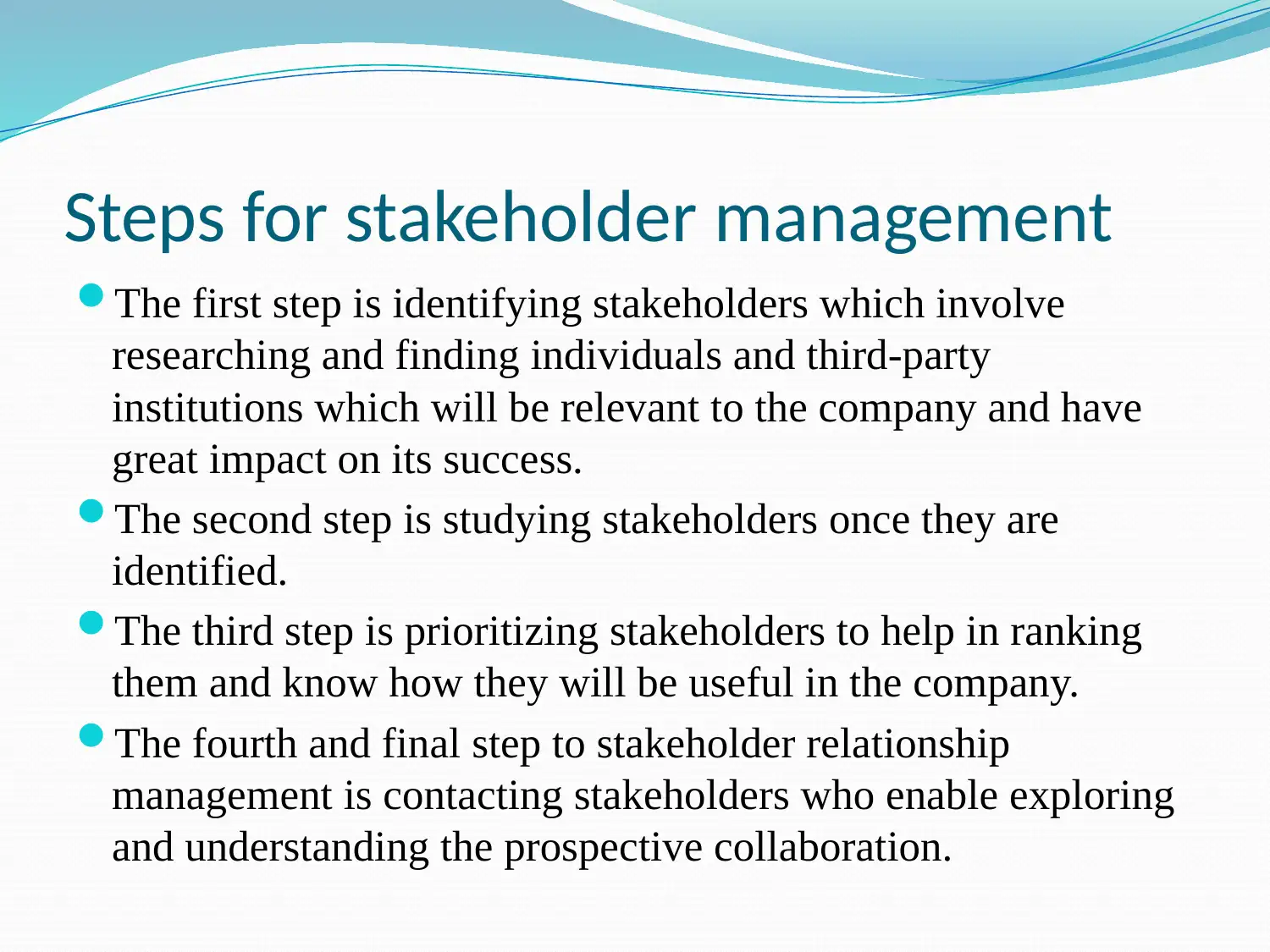
Steps for stakeholder management
The first step is identifying stakeholders which involve
researching and finding individuals and third-party
institutions which will be relevant to the company and have
great impact on its success.
The second step is studying stakeholders once they are
identified.
The third step is prioritizing stakeholders to help in ranking
them and know how they will be useful in the company.
The fourth and final step to stakeholder relationship
management is contacting stakeholders who enable exploring
and understanding the prospective collaboration.
The first step is identifying stakeholders which involve
researching and finding individuals and third-party
institutions which will be relevant to the company and have
great impact on its success.
The second step is studying stakeholders once they are
identified.
The third step is prioritizing stakeholders to help in ranking
them and know how they will be useful in the company.
The fourth and final step to stakeholder relationship
management is contacting stakeholders who enable exploring
and understanding the prospective collaboration.
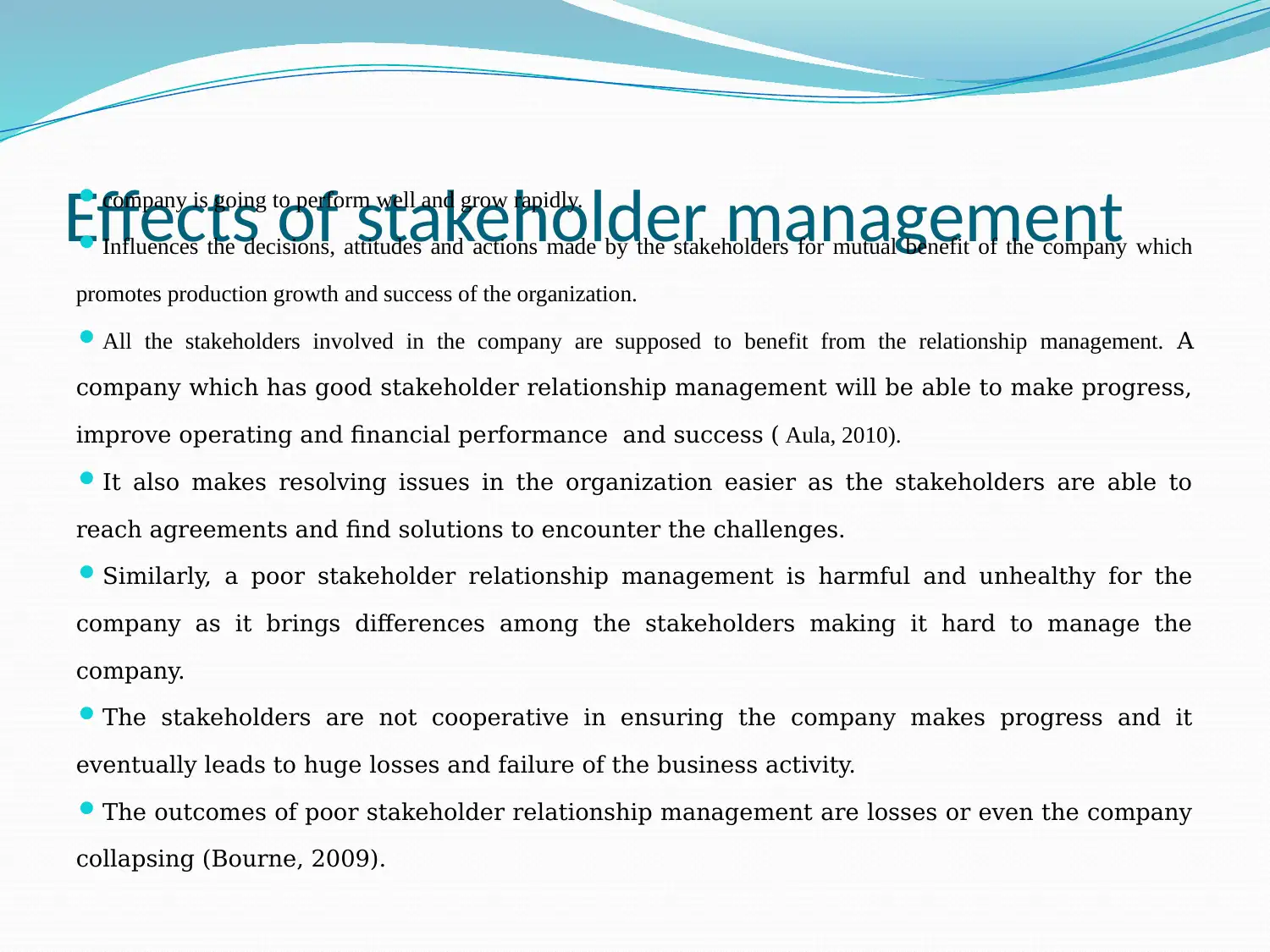
Effects of stakeholder management
company is going to perform well and grow rapidly.
Influences the decisions, attitudes and actions made by the stakeholders for mutual benefit of the company which
promotes production growth and success of the organization.
All the stakeholders involved in the company are supposed to benefit from the relationship management. A
company which has good stakeholder relationship management will be able to make progress,
improve operating and financial performance and success ( Aula, 2010).
It also makes resolving issues in the organization easier as the stakeholders are able to
reach agreements and find solutions to encounter the challenges.
Similarly, a poor stakeholder relationship management is harmful and unhealthy for the
company as it brings differences among the stakeholders making it hard to manage the
company.
The stakeholders are not cooperative in ensuring the company makes progress and it
eventually leads to huge losses and failure of the business activity.
The outcomes of poor stakeholder relationship management are losses or even the company
collapsing (Bourne, 2009).
company is going to perform well and grow rapidly.
Influences the decisions, attitudes and actions made by the stakeholders for mutual benefit of the company which
promotes production growth and success of the organization.
All the stakeholders involved in the company are supposed to benefit from the relationship management. A
company which has good stakeholder relationship management will be able to make progress,
improve operating and financial performance and success ( Aula, 2010).
It also makes resolving issues in the organization easier as the stakeholders are able to
reach agreements and find solutions to encounter the challenges.
Similarly, a poor stakeholder relationship management is harmful and unhealthy for the
company as it brings differences among the stakeholders making it hard to manage the
company.
The stakeholders are not cooperative in ensuring the company makes progress and it
eventually leads to huge losses and failure of the business activity.
The outcomes of poor stakeholder relationship management are losses or even the company
collapsing (Bourne, 2009).
Secure Best Marks with AI Grader
Need help grading? Try our AI Grader for instant feedback on your assignments.
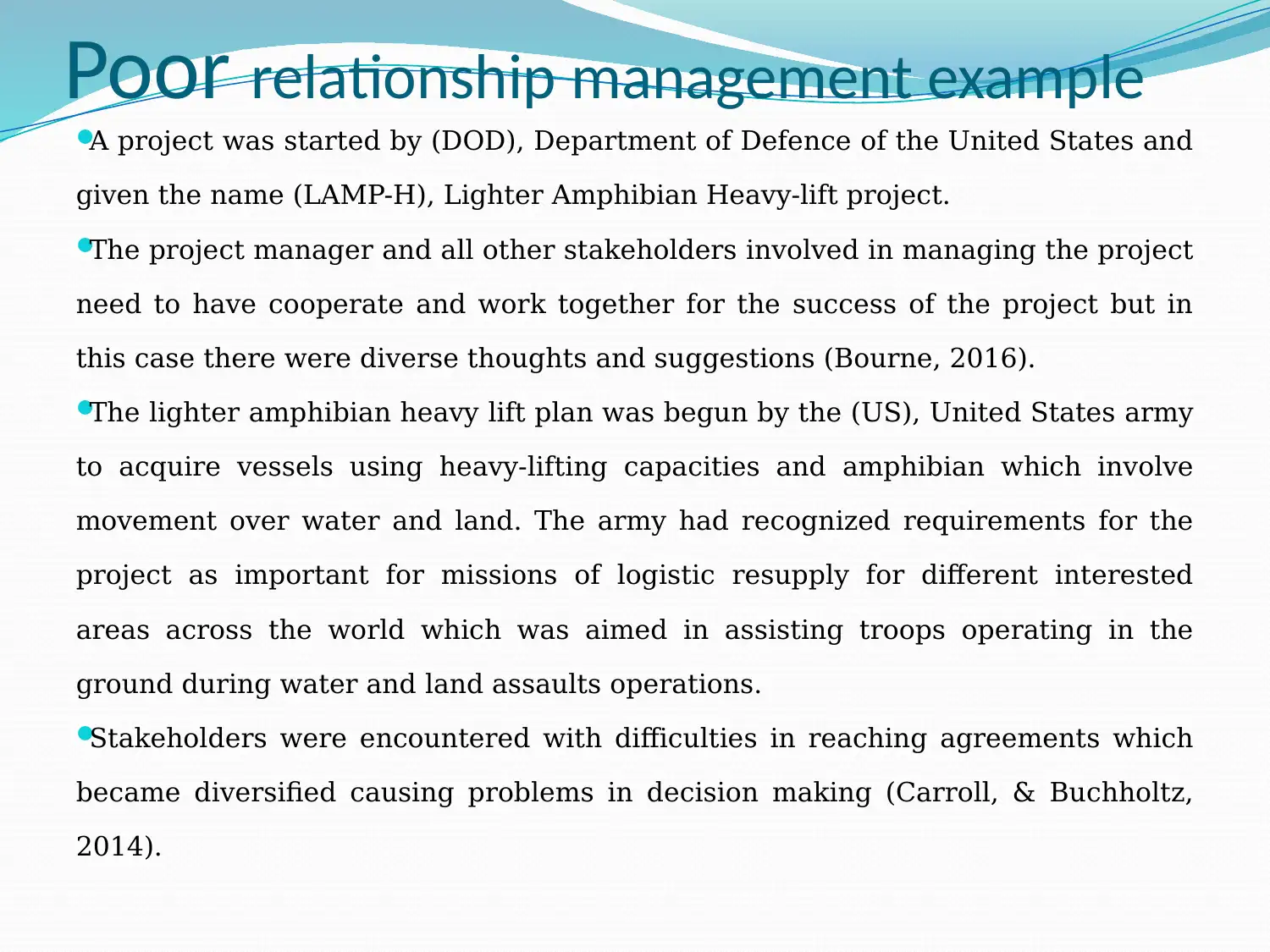
Poor relationship management example
A project was started by (DOD), Department of Defence of the United States and
given the name (LAMP-H), Lighter Amphibian Heavy-lift project.
The project manager and all other stakeholders involved in managing the project
need to have cooperate and work together for the success of the project but in
this case there were diverse thoughts and suggestions (Bourne, 2016).
The lighter amphibian heavy lift plan was begun by the (US), United States army
to acquire vessels using heavy-lifting capacities and amphibian which involve
movement over water and land. The army had recognized requirements for the
project as important for missions of logistic resupply for different interested
areas across the world which was aimed in assisting troops operating in the
ground during water and land assaults operations.
Stakeholders were encountered with difficulties in reaching agreements which
became diversified causing problems in decision making (Carroll, & Buchholtz,
2014).
A project was started by (DOD), Department of Defence of the United States and
given the name (LAMP-H), Lighter Amphibian Heavy-lift project.
The project manager and all other stakeholders involved in managing the project
need to have cooperate and work together for the success of the project but in
this case there were diverse thoughts and suggestions (Bourne, 2016).
The lighter amphibian heavy lift plan was begun by the (US), United States army
to acquire vessels using heavy-lifting capacities and amphibian which involve
movement over water and land. The army had recognized requirements for the
project as important for missions of logistic resupply for different interested
areas across the world which was aimed in assisting troops operating in the
ground during water and land assaults operations.
Stakeholders were encountered with difficulties in reaching agreements which
became diversified causing problems in decision making (Carroll, & Buchholtz,
2014).
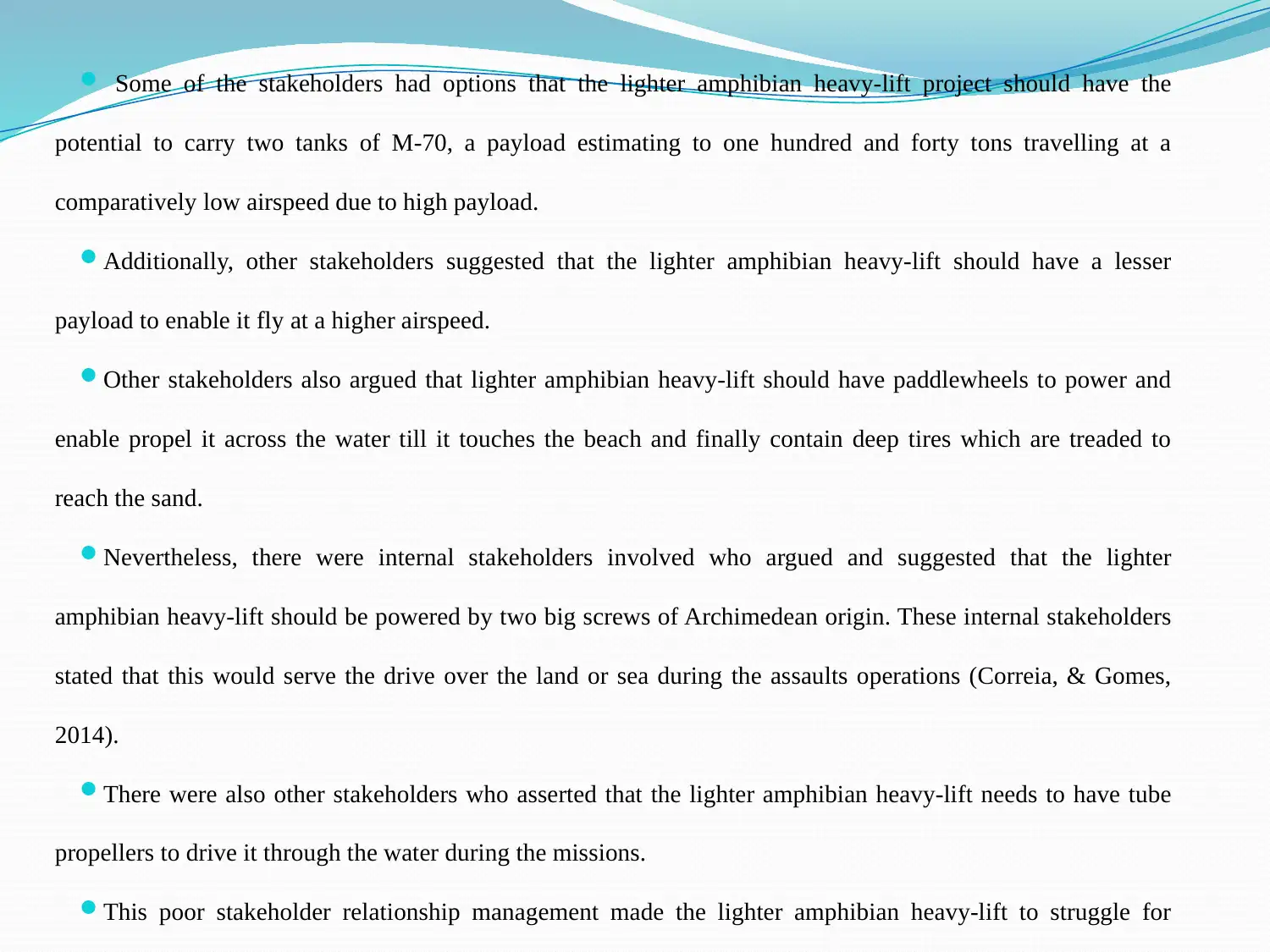
Some of the stakeholders had options that the lighter amphibian heavy-lift project should have the
potential to carry two tanks of M-70, a payload estimating to one hundred and forty tons travelling at a
comparatively low airspeed due to high payload.
Additionally, other stakeholders suggested that the lighter amphibian heavy-lift should have a lesser
payload to enable it fly at a higher airspeed.
Other stakeholders also argued that lighter amphibian heavy-lift should have paddlewheels to power and
enable propel it across the water till it touches the beach and finally contain deep tires which are treaded to
reach the sand.
Nevertheless, there were internal stakeholders involved who argued and suggested that the lighter
amphibian heavy-lift should be powered by two big screws of Archimedean origin. These internal stakeholders
stated that this would serve the drive over the land or sea during the assaults operations (Correia, & Gomes,
2014).
There were also other stakeholders who asserted that the lighter amphibian heavy-lift needs to have tube
propellers to drive it through the water during the missions.
This poor stakeholder relationship management made the lighter amphibian heavy-lift to struggle for
potential to carry two tanks of M-70, a payload estimating to one hundred and forty tons travelling at a
comparatively low airspeed due to high payload.
Additionally, other stakeholders suggested that the lighter amphibian heavy-lift should have a lesser
payload to enable it fly at a higher airspeed.
Other stakeholders also argued that lighter amphibian heavy-lift should have paddlewheels to power and
enable propel it across the water till it touches the beach and finally contain deep tires which are treaded to
reach the sand.
Nevertheless, there were internal stakeholders involved who argued and suggested that the lighter
amphibian heavy-lift should be powered by two big screws of Archimedean origin. These internal stakeholders
stated that this would serve the drive over the land or sea during the assaults operations (Correia, & Gomes,
2014).
There were also other stakeholders who asserted that the lighter amphibian heavy-lift needs to have tube
propellers to drive it through the water during the missions.
This poor stakeholder relationship management made the lighter amphibian heavy-lift to struggle for
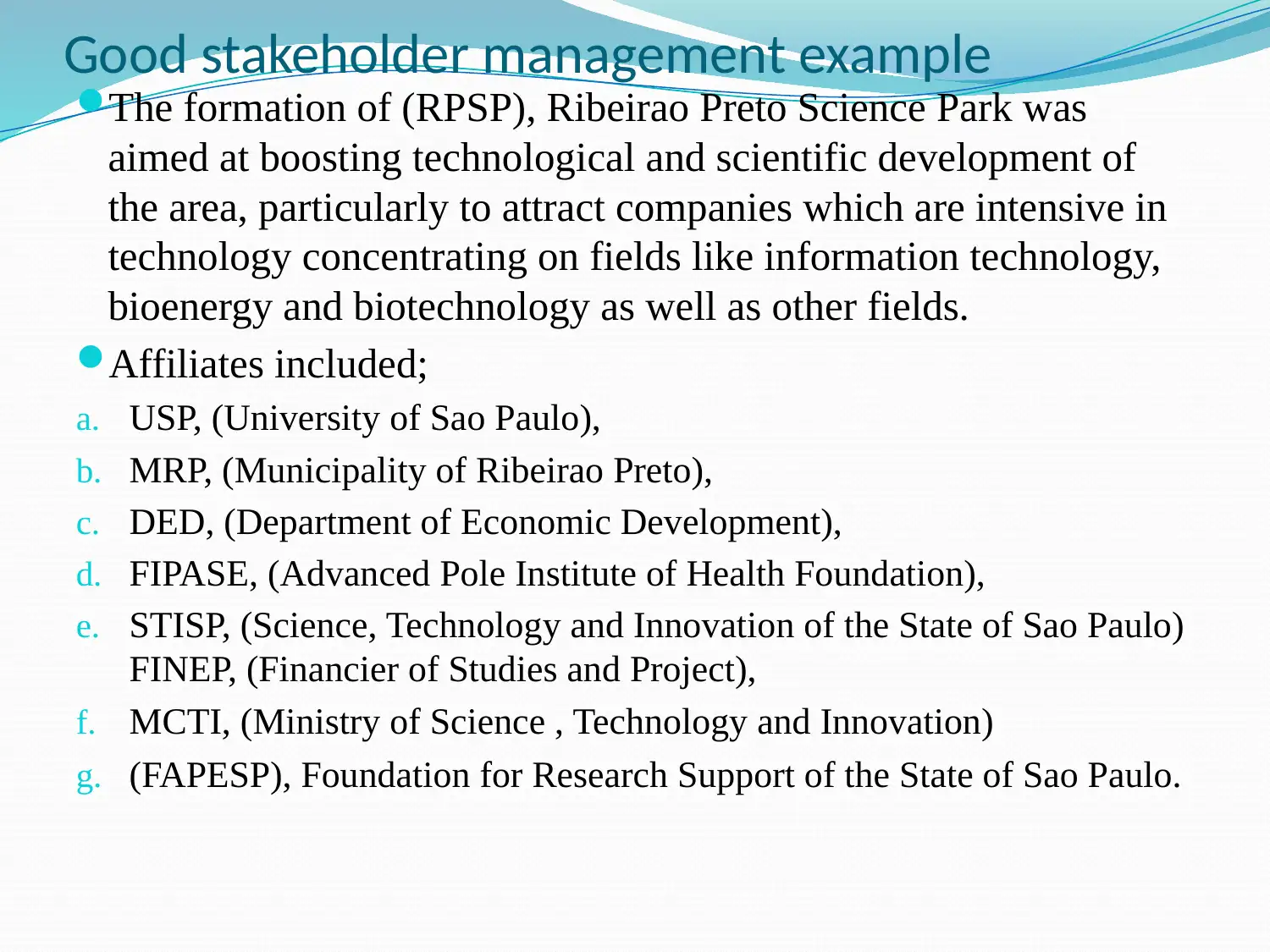
Good stakeholder management example
The formation of (RPSP), Ribeirao Preto Science Park was
aimed at boosting technological and scientific development of
the area, particularly to attract companies which are intensive in
technology concentrating on fields like information technology,
bioenergy and biotechnology as well as other fields.
Affiliates included;
a. USP, (University of Sao Paulo),
b. MRP, (Municipality of Ribeirao Preto),
c. DED, (Department of Economic Development),
d. FIPASE, (Advanced Pole Institute of Health Foundation),
e. STISP, (Science, Technology and Innovation of the State of Sao Paulo)
FINEP, (Financier of Studies and Project),
f. MCTI, (Ministry of Science , Technology and Innovation)
g. (FAPESP), Foundation for Research Support of the State of Sao Paulo.
The formation of (RPSP), Ribeirao Preto Science Park was
aimed at boosting technological and scientific development of
the area, particularly to attract companies which are intensive in
technology concentrating on fields like information technology,
bioenergy and biotechnology as well as other fields.
Affiliates included;
a. USP, (University of Sao Paulo),
b. MRP, (Municipality of Ribeirao Preto),
c. DED, (Department of Economic Development),
d. FIPASE, (Advanced Pole Institute of Health Foundation),
e. STISP, (Science, Technology and Innovation of the State of Sao Paulo)
FINEP, (Financier of Studies and Project),
f. MCTI, (Ministry of Science , Technology and Innovation)
g. (FAPESP), Foundation for Research Support of the State of Sao Paulo.
Paraphrase This Document
Need a fresh take? Get an instant paraphrase of this document with our AI Paraphraser
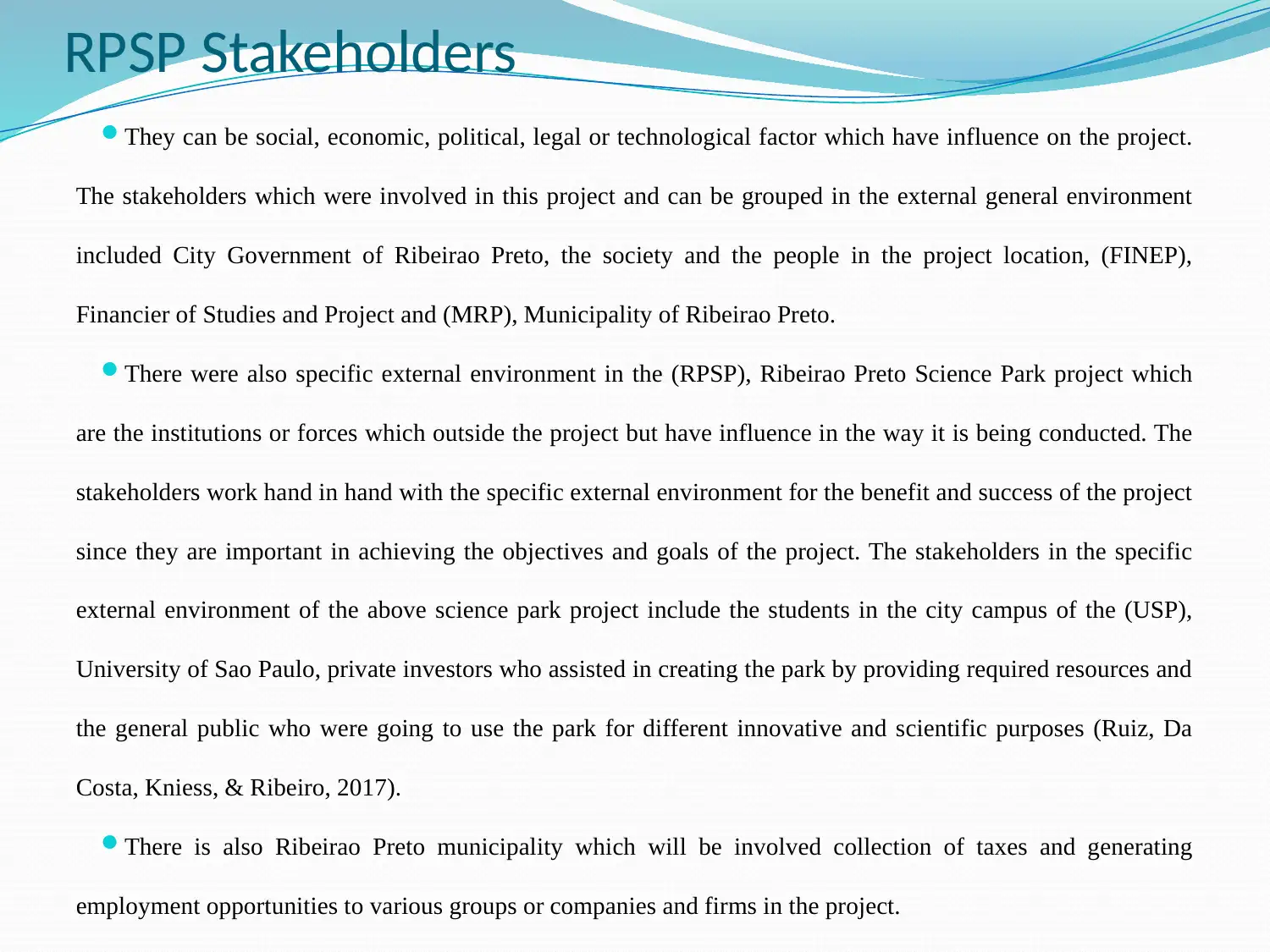
RPSP Stakeholders
They can be social, economic, political, legal or technological factor which have influence on the project.
The stakeholders which were involved in this project and can be grouped in the external general environment
included City Government of Ribeirao Preto, the society and the people in the project location, (FINEP),
Financier of Studies and Project and (MRP), Municipality of Ribeirao Preto.
There were also specific external environment in the (RPSP), Ribeirao Preto Science Park project which
are the institutions or forces which outside the project but have influence in the way it is being conducted. The
stakeholders work hand in hand with the specific external environment for the benefit and success of the project
since they are important in achieving the objectives and goals of the project. The stakeholders in the specific
external environment of the above science park project include the students in the city campus of the (USP),
University of Sao Paulo, private investors who assisted in creating the park by providing required resources and
the general public who were going to use the park for different innovative and scientific purposes (Ruiz, Da
Costa, Kniess, & Ribeiro, 2017).
There is also Ribeirao Preto municipality which will be involved collection of taxes and generating
employment opportunities to various groups or companies and firms in the project.
They can be social, economic, political, legal or technological factor which have influence on the project.
The stakeholders which were involved in this project and can be grouped in the external general environment
included City Government of Ribeirao Preto, the society and the people in the project location, (FINEP),
Financier of Studies and Project and (MRP), Municipality of Ribeirao Preto.
There were also specific external environment in the (RPSP), Ribeirao Preto Science Park project which
are the institutions or forces which outside the project but have influence in the way it is being conducted. The
stakeholders work hand in hand with the specific external environment for the benefit and success of the project
since they are important in achieving the objectives and goals of the project. The stakeholders in the specific
external environment of the above science park project include the students in the city campus of the (USP),
University of Sao Paulo, private investors who assisted in creating the park by providing required resources and
the general public who were going to use the park for different innovative and scientific purposes (Ruiz, Da
Costa, Kniess, & Ribeiro, 2017).
There is also Ribeirao Preto municipality which will be involved collection of taxes and generating
employment opportunities to various groups or companies and firms in the project.
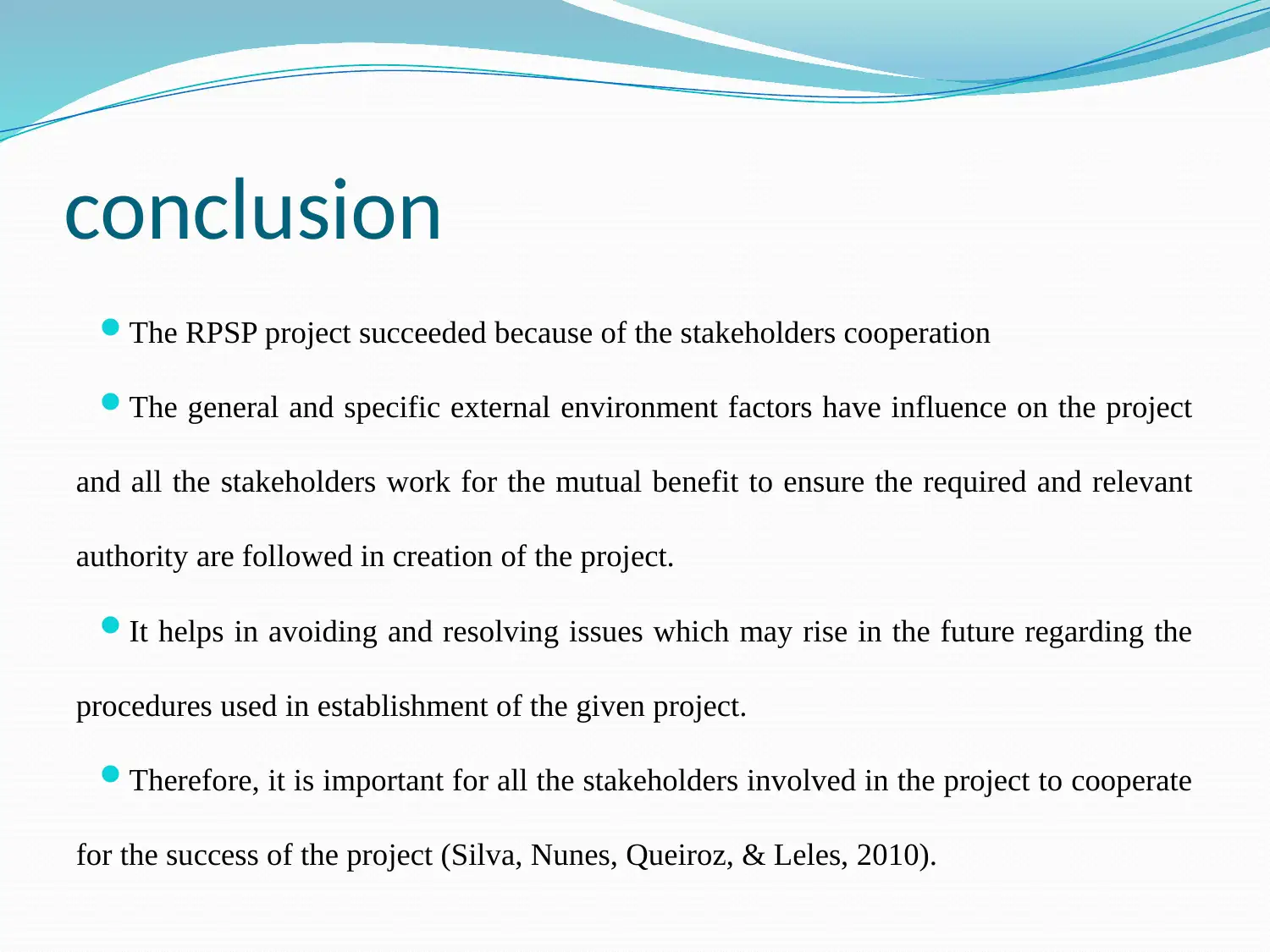
conclusion
The RPSP project succeeded because of the stakeholders cooperation
The general and specific external environment factors have influence on the project
and all the stakeholders work for the mutual benefit to ensure the required and relevant
authority are followed in creation of the project.
It helps in avoiding and resolving issues which may rise in the future regarding the
procedures used in establishment of the given project.
Therefore, it is important for all the stakeholders involved in the project to cooperate
for the success of the project (Silva, Nunes, Queiroz, & Leles, 2010).
The RPSP project succeeded because of the stakeholders cooperation
The general and specific external environment factors have influence on the project
and all the stakeholders work for the mutual benefit to ensure the required and relevant
authority are followed in creation of the project.
It helps in avoiding and resolving issues which may rise in the future regarding the
procedures used in establishment of the given project.
Therefore, it is important for all the stakeholders involved in the project to cooperate
for the success of the project (Silva, Nunes, Queiroz, & Leles, 2010).
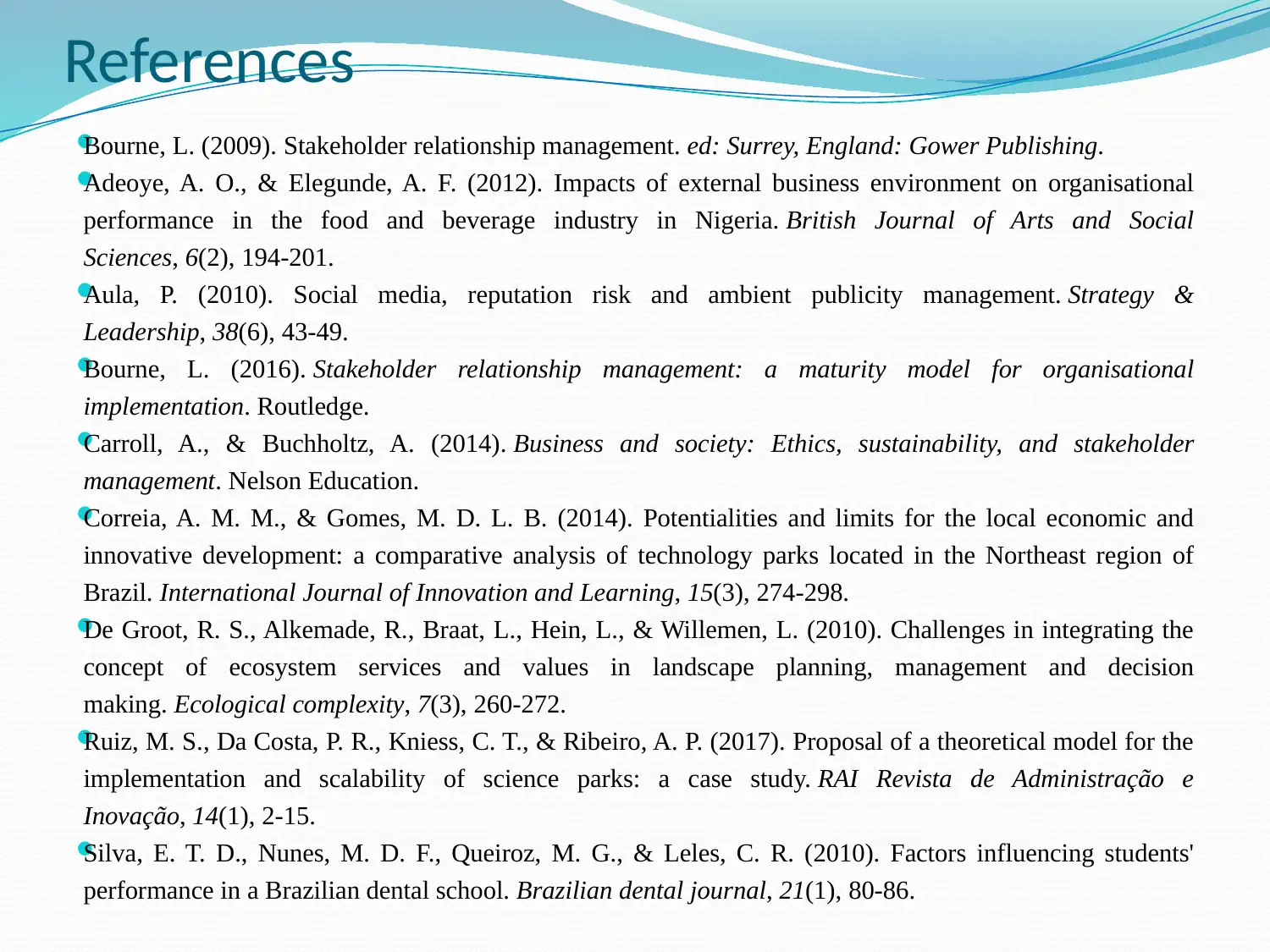
References
Bourne, L. (2009). Stakeholder relationship management. ed: Surrey, England: Gower Publishing.
Adeoye, A. O., & Elegunde, A. F. (2012). Impacts of external business environment on organisational
performance in the food and beverage industry in Nigeria. British Journal of Arts and Social
Sciences, 6(2), 194-201.
Aula, P. (2010). Social media, reputation risk and ambient publicity management. Strategy &
Leadership, 38(6), 43-49.
Bourne, L. (2016). Stakeholder relationship management: a maturity model for organisational
implementation. Routledge.
Carroll, A., & Buchholtz, A. (2014). Business and society: Ethics, sustainability, and stakeholder
management. Nelson Education.
Correia, A. M. M., & Gomes, M. D. L. B. (2014). Potentialities and limits for the local economic and
innovative development: a comparative analysis of technology parks located in the Northeast region of
Brazil. International Journal of Innovation and Learning, 15(3), 274-298.
De Groot, R. S., Alkemade, R., Braat, L., Hein, L., & Willemen, L. (2010). Challenges in integrating the
concept of ecosystem services and values in landscape planning, management and decision
making. Ecological complexity, 7(3), 260-272.
Ruiz, M. S., Da Costa, P. R., Kniess, C. T., & Ribeiro, A. P. (2017). Proposal of a theoretical model for the
implementation and scalability of science parks: a case study. RAI Revista de Administração e
Inovação, 14(1), 2-15.
Silva, E. T. D., Nunes, M. D. F., Queiroz, M. G., & Leles, C. R. (2010). Factors influencing students'
performance in a Brazilian dental school. Brazilian dental journal, 21(1), 80-86.
Bourne, L. (2009). Stakeholder relationship management. ed: Surrey, England: Gower Publishing.
Adeoye, A. O., & Elegunde, A. F. (2012). Impacts of external business environment on organisational
performance in the food and beverage industry in Nigeria. British Journal of Arts and Social
Sciences, 6(2), 194-201.
Aula, P. (2010). Social media, reputation risk and ambient publicity management. Strategy &
Leadership, 38(6), 43-49.
Bourne, L. (2016). Stakeholder relationship management: a maturity model for organisational
implementation. Routledge.
Carroll, A., & Buchholtz, A. (2014). Business and society: Ethics, sustainability, and stakeholder
management. Nelson Education.
Correia, A. M. M., & Gomes, M. D. L. B. (2014). Potentialities and limits for the local economic and
innovative development: a comparative analysis of technology parks located in the Northeast region of
Brazil. International Journal of Innovation and Learning, 15(3), 274-298.
De Groot, R. S., Alkemade, R., Braat, L., Hein, L., & Willemen, L. (2010). Challenges in integrating the
concept of ecosystem services and values in landscape planning, management and decision
making. Ecological complexity, 7(3), 260-272.
Ruiz, M. S., Da Costa, P. R., Kniess, C. T., & Ribeiro, A. P. (2017). Proposal of a theoretical model for the
implementation and scalability of science parks: a case study. RAI Revista de Administração e
Inovação, 14(1), 2-15.
Silva, E. T. D., Nunes, M. D. F., Queiroz, M. G., & Leles, C. R. (2010). Factors influencing students'
performance in a Brazilian dental school. Brazilian dental journal, 21(1), 80-86.
1 out of 10
Related Documents
Your All-in-One AI-Powered Toolkit for Academic Success.
+13062052269
info@desklib.com
Available 24*7 on WhatsApp / Email
![[object Object]](/_next/static/media/star-bottom.7253800d.svg)
Unlock your academic potential
© 2024 | Zucol Services PVT LTD | All rights reserved.




